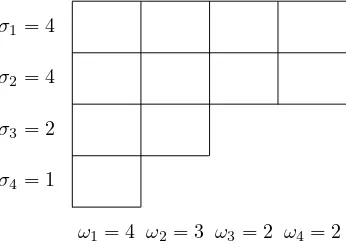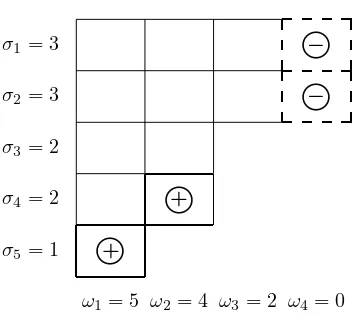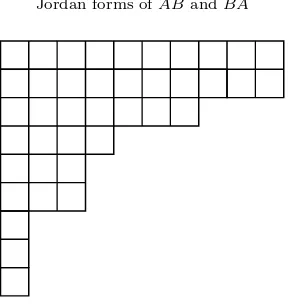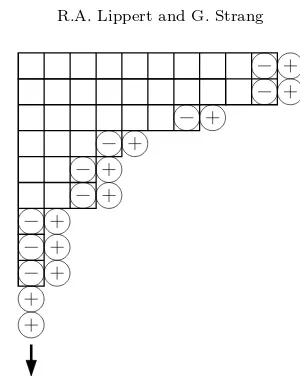THE JORDAN FORMS OFAB ANDBA∗
ROSS A. LIPPERT† AND GILBERT STRANG‡
Abstract. The relationship between the Jordan forms of the matrix productsABandBAfor some givenAandBwas first described by Harley Flanders in 1951. Their non-zero eigenvalues and non-singular Jordan structures are the same, but their singular Jordan block sizes can differ by 1. We present an elementary proof that owes its simplicity to a novel use of the Weyr characteristic.
Key words. Jordan form, Weyr characteristic, eigenvalues
AMS subject classifications.15A21, 15A18
1. Introduction. Suppose Aand B aren×n complex matrices, and suppose Ais invertible. ThenAB=A(BA)A−1. The matricesABandBAare similar. They
have the same eigenvalues with the same multiplicities, and more than that, they have the same Jordan form. This conclusion is equally true ifB is invertible.
I f bothAandB are singular (and square), a limiting argument involvingA+ǫI is useful. In this case AB and BA still have the same eigenvalues with the same multiplicities. What the argument does not prove (because it is not true) is thatAB is similar to BA. Their Jordan forms may be different, in the sizes of the blocks associated with the eigenvalueλ= 0. This paper studies that difference in the block sizes.
The block sizes can increase or decrease by 1. This is illustrated by an example in which AB has Jordan blocks of sizes 2 and 1 while BA has three 1 by 1 blocks. We could begin with Jordan matricesAandB:
A=
0 1 0 0 0 0 0 0 0
and B=
1 0 0 0 0 0 0 0 0
The productAB is zero. The product BA also has a triple zero eigenvalue but the
∗Received by the editors May 5, 2009. Accepted for publication May 28, 2009. Handling Editor:
Roger A. Horn.
†123 West 92 Street #1, New York, NY 10025, USA ([email protected]).
‡MIT Department of Mathematics, 77 Massachusetts Avenue, Building Room 2-240, Cambridge,
MA 02139, USA ([email protected]).
rank is 1. In fact,BAis in Jordan form:
BA=
0 1 0 0 0 0 0 0 0
A different 3 by 3 example illustrates another possibility:
A=
0 1 0 0 0 1 0 0 0
and B=
1 0 0 0 1 0 0 0 0
with
AB=
0 1 0 0 0 0 0 0 0
and BA=
0 1 0 0 0 1 0 0 0
Those examples show all the possible differences for n = 3, when AB is nilpotent. More generally, we want to find every possible pair of Jordan forms for AB and BA, for anyn×mmatrixAand m×n matrixB over an algebraically closed field. The solution to this problem, generalized to matrices over an arbitrary field, was given over 50 years ago by Harley Flanders [3], with subsequent generalizations and specializations [4, 6]. In this article, we give a novel elementary proof by using the Weyr characteristic.
2. The Weyr Characteristic. There are two dual descriptions of the Jordan block sizes for a specific eigenvalue. We can list the block dimensionsσi in decreasing order, giving the row lengths in Figure 2.1. This is the Segre characteristic. We can
σ1= 4
σ2= 4
σ3= 2
σ4= 1
[image:2.612.173.346.467.593.2]ω1= 4 ω2= 3 ω3= 2 ω4= 2
Fig. 2.1.A tableau representing the Jordan structureJ4⊕J4⊕J2⊕J1.
This is the Weyr characteristic. By convention, we define σi andωi for all i >0 by setting them to 0 for sufficiently largei. I f we consider{σi}and{ωj}to be partitions of their common sumn, then they areconjugate partitions: σi counts the number of j’s for which ωj ≥i and vice versa. The relationship between conjugate partitions
{σi}and{ωi}is compactly summarized by ωσi≥i > ωσi+1 (or byσωi≥i > σωi+1),
the first inequality making sense only when σi > 0. Tying the two descriptions to linear algebra is thenullity indexνj:
νj(A) = dimN ull(Aj) = dimension of the nullspace ofAj (withν0(A) = 0).
Thusνjcounts the number of generalized eigenvectors forλ= 0 withheightjor less. In the example in Figure 2.1,ν0, . . . , ν5 are 0,4,7,9,11. Thenωj =νj−νj−1 counts
the number of Jordan blocks of sizeior greater forλ= 0. Further exposition of the Weyr characteristic can be found in [5] and some geometric applications in [1, 2].
Our main theorem is captured in the statement that ωi(BA) ≥ ωi+1(AB).
Re-versingAandB gives a parallel inequality that we re-index asωi−1(AB)≥ωi(BA). This observation, although in different terms, was central to the original proof by Flanders [3].
Theorem 2.1. Let F be an algebraically closed field. Given A, Bt ∈ Fn×m, the non-singular Jordan blocks of AB andBA have matching sizes, i.e., their Weyr characteristics are equal:
ωi(AB−λI) =ωi(BA−λI) for λ= 0 and alli. (2.1)
For the eigenvalueλ= 0, the Jordan forms ofABandBAhave Weyr characteristics that satisfy
ωi−1(AB)≥ωi(BA)≥ωi+1(AB) for all i,
(2.2)
which is equivalent to
|σi(AB)−σi(BA)| ≤1 for alli. (2.3)
If P ∈ Fn×n and Q ∈ Fm×m satisfy ωi(P −λI) = ωi(Q−λI) for λ = 0 and ωi−1(P)≤ωi(Q)≤ωi+1(P), then there exist A, Bt∈Fn×m such that P =AB and
Q=BA.
The equivalence of (2.2) and (2.3) is purely a combinatorial property of conjugate partitions (see Lemma 3.2).
−
−
+
+
❧ ❧
❧ ❧
σ1= 3
σ2= 3
σ3= 2
σ4= 2
σ5= 1
[image:4.612.171.349.102.262.2]ω1= 5 ω2= 4 ω3= 2 ω4= 0
Fig. 2.2. If AB is nilpotent with Jordan structureJ4⊕J4⊕J2⊕J1, then a permitted BA
structure isJ3⊕J3⊕J2⊕J2⊕J1.
3. Main results. Our results are ultimately derived from the associativity of matrix multiplication. A typical example isB(AB· · ·AB) = (BA· · ·BA)B.
Theorem 3.1. IfA andBtaren×mmatrices over a field F, then for alli >0 ωi(AB−λI) =ωi(BA−λI) forλ∈F− {0}
ωi(BA)≥ωi+1(AB) (forλ= 0).
Proof. (For λ = 0) For any polynomial p(x), p(BA)B = Bp(AB). Thus p(AB)v = 0 implies p(BA)Bv = 0. Since Bv = 0 implies p(AB)v = p(0)v, we have dimN ull(p(AB)) = dimN ull(p(BA)) when p(0) = 0. Hence νi(AB−λI) = νi(BA−λI) whenλ= 0.
(Forλ= 0) We define the following nullspaces fori≥0:
Ri={v∈Fn:B(AB)iv= 0}
R′
i={v∈F
n: (AB)iv= 0}
Li={v∈Fm:vt(BA)i = 0}
L′
i={v∈F
m:vt(BA)iB = 0}
We see that,Ri⊂ R′i+1 andLi ⊂ L′i+1, and dim{Ri+1} −dim{Ri}= dim{L′i+1} − dim{L′
i}.
Let v1, . . . , vk ∈ R′i+2 be a set of vectors that are linearly independent
Fig. 3.1. A tableau representing the Jordan structureσi= (10,10,7,4,3,3,1,1,1,0, . . .), with
Weyr characteristicωi= (9,6,6,4,3,3,3,2,2,2,0, . . .).
ABv1, . . . , ABvk∈ R′i+1 are linearly independent moduloRi. Thus, dim{R′
i+1/Ri} ≥ dim{R′i+2/Ri+1}. I fv1, . . . , vk ∈ L′i+2 is a set of vectors, linearly
independent moduloLi+1, then the vectors (BA)tv1, . . . ,(BA)tvk ∈ L′i+1are linearly
independent moduloLi. Thus, dim{L′i+1/Li} ≥dim{L′i+2/Li+1}. Notice that dim{R′i+2/Ri+1}=νi+2(AB)−dim{Ri+1}
dim{L′i+2/Li+1}= dim{L′i+2} −νi+1(BA).
Then dim{R′
i+1/Ri} ≥dim{R′i+2/Ri+1} implies
dim{Ri+2} −dim{Ri+1} ≥νi+2(AB)−νi+1(AB)
and dim{L′
i+1/Li} ≥dim{L′i+2/Li+1}implies
νi+1(BA)−νi(BA)≥dim{L′i+2} −dim{L′i+1}.
Therefore,ωi+1(BA)≥ωi+2(AB), sinceωi+1=νi+1−νi.
The first part of Theorem 3.1 says that the Jordan structures ofABandBAfor λ= 0 are identical, ifFis algebraically closed. For a general field, the results can be
adapted to show that the elementary divisors of ABandBA, that do not have zero as a root, are the same. An illustration is helpful in understanding the constraints implied by the second part, ωi−1(AB)≥ωi(BA)≥ωi+1(AB). Suppose the tableau
in Figure 3.1 represents the Jordan form ofABatλ= 0. Theorem 3.1 constrains the tableau of the Jordan form ofBAatλ= 0 to be that ofABplus or minus the areas covered by the circles of Figure 3.2.
Fig. 3.2.GivenAB(boxes), Theorem 3.1 imposes these constraints on the Weyr characteristic ofBA(a circle can be added or subtracted from each row of the tableau): ω1≥6,9≥ω2 ≥6,6≥
ω3≥4,6≥ω4≥3,4≥ω5≥3, ω6= 3,3≥ω7≥2,3≥ω8≥2, ω9= 2,2≥ω9≥0,2≥ω10≥0.
equivalence “is not hard to see” [3] from Figure 3.1, it warrants a short proof. Taking d= 1, Lemma 3.2 establishes the equivalence of (2.2) and (2.3).
Lemma 3.2. Let p1≥p2≥ · · · andp1′ ≥p′2 ≥ · · ·be partitions of n andn′ with
conjugate partitions q1≥q2≥ · · ·andq1′ ≥q2′ ≥ · · ·. Letd∈N. Then
q′
i≥qi+d andqi≥q′i+d for all i >0 if and only if|pi−p′i| ≤dfor alli >0. Proof. I fp′
i> d, thenq′p′
i ≥i > qpi+1by the conjugacy conditions. By hypothesis,
qp′
i−d≥q
′
p′
i> qpi+1and thusp
′
i−d < pi+ 1 sinceqj is monotonically decreasing inj. Thusp′
i≤pi+d(trivially true whenp′i≤d). By a symmetric argument (switching primed and unprimed), we havepi≤p′i+d.
Conversely, if qi+d >0, then p′qi+d ≥ pqi+d −d ≥ (i+d)−d =i > p
′
q′
i+1, the
first inequality by hypothesis and the next two by the conjugacy conditions. Sincep′
j is monotonically decreasing, we have qi+d < qi′+ 1, and thus qi+d ≤q′i for alli >0 (trivially true whenqi+d= 0). A symmetric argument givesqi′+d ≤qi.
What remains is to show that the constraints in Theorem 3.1 are exhaustive; we can construct matricesA, B that realize all the possibilities of the theorem. Here we find it easier to use the traditional Segre characteristic of block sizesσi:
Theorem 3.3. Let σ1 ≥σ2 ≥ · · · and σ′
1 ≥σ2′ ≥ · · · be partitions of n and m
respectively.
Proof. For eachj such thatσj andσj′ ≥1, we constructσj×σj′ matricesAj and Bt
j such thatAjBj=Jσj(0) and BjAj =Jσ′j(0) according to these three cases:
1. σj =σj′: setAj=Jσj(0) andBj =Iσj,
2. σj+ 1 =σ′j: setAj= [ 0 Iσj] and Bj=
Iσj
0
,
3. σj =σj′ + 1: setAj= I
σ′
j
0
and Bj= [ 0 Iσ′
j].
This defines k = min{ω1(AB), ω1(BA)} matrix pairs (Aj, Bj). Consider{σj} as a partition for n rows and
σ′
j as a partition for m columns. Construct the block diagonal matrixA= diag(A1, . . . , Ak,0, . . . ,0) with zeros filling any remaining lower right part. Then with partitions
σ′
j for mrows and {σj} for n columns letB = diag(B1, . . . , Bk,0, . . . ,0).
The final construction merely stitches together a singular piece with a non-singular piece.
Corollary 3.4. Let P ∈ Fn×n and Q∈ Fm×m have Segre characteristics σλ i andσ′λ
i for each eigenvalueλ, i.e.
P ∼
λ∈F
i>0
Jσλ
i(λ) and Q∼
λ∈F
i>0
Jσ′λ i (λ).
If σλ i =σ′
λ
i for all λ= 0 and |σ
0
i −σ′0i | ≤1, then there exist matrices A and B t in
Fn×msuch that P =ABandQ=BA.
Proof. I f ˜P = X−1P X and ˜Q =Y−1QY are in canonical form with ˜P = ˜AB˜
and ˜Q = ˜BA˜, then setting A =XAY˜ −1 and B =YBX˜ −1, we have P = AB and
Q=BA. Hence we takeP andQto be in canonical form.
LetM = λ=0
i>0Jσi(λ), i.e., M is a (non-singular)k×k matrix in Jordan
canonical form with Segre characteristic σλ
i, where k =
λ=0
iσ
λ
i. Let A0 and
B0 be the A and B matrices from Theorem 3.3 with σi = σi0 and σi′ =σ′0i . Then
A=M ⊕A0and B=Ik⊕B0.
Acknowledgment. We thank Roger Horn for pointing us to the Flanders paper and others, and for his encouragement.
REFERENCES
[1] James W. Demmel and Alan Edelman. The dimension of matrices (matrix pencils) with given Jordan (Kronecker) canonical forms. Linear Algebra Appl., 230:61–87, 1995.
[3] Harley Flanders. Elementary divisors of AB and BA. Proc. Amer. Math. Soc., 2(6):871–874, 1951.
[4] W. V. Parker and B. E. Mitchell. Elementary divisors of certain matrices. Duke Math. J., 19(3):483–485, 1952.



